López Gil Francisco José
Laser treatments can be for:
Stretch marks and scars
One of the newest advances in laser therapy is the treatment of stretch marks after pregnancy or with growth in adolescence (if the marks are less than one year old). We use a non –ablative Fractional Erbium Laser that gives excellent results in only 4-6 sessions.
Equally successful are the results with using this treatment on scars following surgery, burns, accidents etc

Before - 3 months after
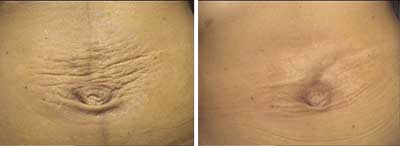
Postpartum stretch marks - Láser 1540, 4 sessions after
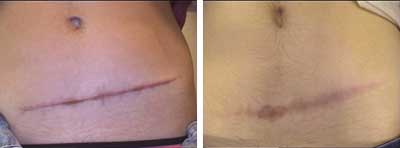 Keloid scar - Laser 1540, 6 sessions after
Keloid scar - Laser 1540, 6 sessions after 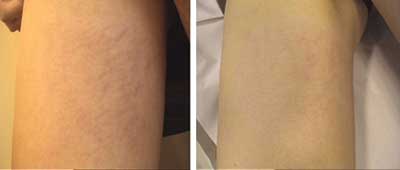 Stretch marks - Laser 1540, 4 sessions after
Stretch marks - Laser 1540, 4 sessions after Facial rejuvenation
There are two kinds of laser treatments available to improve sun damaged skin or skin that has varying degrees of wrinkles:
Skin Resurfacing (ablative treatment): This is an aggressive form of treatment that leads to the removal of damaged skin whilst promoting the skin's own renewal process. It is effective on fine wrinkles and sunspots. It is the ideal solution for someone who wants a radical improvement in a short space of time.
The most complicated part of the treatment is the post-operative care as it is not possible to go out for 1-2 weeks and can cause a reddening of the skin that can last up to 10 months. It can cause scarring in those people whose skin repairs slowly and in such cases it is essential to do a test on a small area of skin before undertaking the whole treatment.

Before - After
Non-Ablative Facial Rejuvenation: This is a non-aggressive painless procedure that leads to the stimulation of collagen and therefore the renewal of the tissues without damaging the skin surface. Recovery is immediate without even the reddening of the skin. The only inconvenience is that the patient will have to repeat the treatment every 2-4 months until the desired results are achieved.
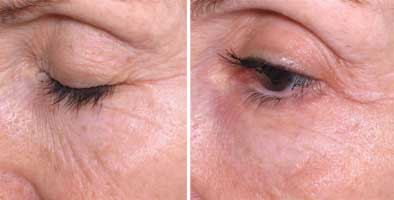
Before - After
Dark spots on the hands and face
Laser treatment is very effective in the removal of dark, or liver, spots from the zones that are most exposed to the sun like on the face, hands and neckline. The laser destroys the spots by breaking up the melanin in the spot itself. Depending on the size of the spots, their age, their colour and the type of skin of the patient it is necessary to have between 2-6 sessions (with 4-6 week intervals between them).
It is a painless procedure that only leaves a small scab which will disappear after 4-5 days. The area concerned will have to be strictly protected from the sun for at least 2 months after the treatment.

Before - After
Laser Hair Removal
Laser treatment is extremely effective for the removal of unwanted body hair as long as the dermatologist has effective and safe laser equipment for using on different types of hair and skin. It is essential that a trained specialist carries out the laser treatment for hair removal. The only downside to this treatment is the cost.
The number of sessions needed depends on the patient's skin colour, the thickness and colour of the hair, the area to be treated as well as any associated hormonal imbalances etc. Facial areas usually require more sessions (6-10) than body areas (3-5), since this hair is more dependent on hormonal stimuli and is generally finer and has less pigment. The costs vary according to the desired body area.
Varicose Veins
When we treat varicose veins we tend to do between 2-4 sessions with intervals of 6 weeks. In some cases we combine the treatment with sclerotherapy.
It is important to bear in mind that the best time to undertake the treatment is in the autumn (or in January of February at the latest) because it is possible that the treatment will leave a darkening of the area treated which may take up to six months to disappear.
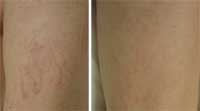 Before - After 2 sessions with laser
Before - After 2 sessions with laser
Cuperosis, red marks, thread veins (or spider veins) and angiomas
The pulsed dye laser is a highly accurate tool which allows us to treat superficial vascular lesions in a safe and effective way. It gives excellent results without damaging the skin. The dilated vessels absorb the light and are coagulated by the thermal affect of the laser. After the treatment the patient can sometimes have reddening of the skin (like an insect bite) but this will disappear after several hours. 1-2 sessions are enough to completely remove these imperfections.
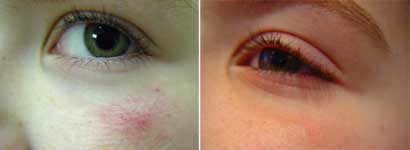
Before - After
Tattoo Removal
Multicoloured and professional tattoos are the most difficult to treat due to the composition of the pigments used. Usually the pigments include a mixture of metallic elements and organic pigments that necessitate more sessions than amateur tattoos to remove. In cosmetic tattoos it is possible to have a darkening of the original tattoo because of the oxidation of the iron or titanium pigment changing the initial colour of the micro pigmentation.
The treatment requires normally 4-8 sessions carried out with 6-8 week intervals. It is essential to use local anaesthetic with this treatment.
The number of sessions depends on the size, age, type and colour of the pigment in the tattoo. The result is excellent if the colours are black-blue; good if the colour is red-brown; and not so good if it is green- yellow.
| Morning | Afternoon | |
|---|---|---|
| Monday | 09.30 - 13.30 h | 15.30 - 19.00 h |
| Tuesday | 09.30 - 13.30 h | 15.30 - 19.00 h |
| Wednesday | 09.30 - 13.30 h | 15.30 - 19.00 h |
| Thursday | 09.30 - 13.30 h | 15.30 - 19.00 h |
| Friday | 09.30 - 13.30 h | 15.30 - 19.00 h |















